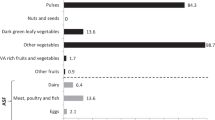Abstract
Objective: To investigate the prevalence of vitamin A deficiency among adolescent female factory workers in Bangladesh, and examine the association between various factors and vitamin A status. Design: A cross-sectional study. Setting: Garment factories in Dhaka city, Bangladesh. Subjects: Three hundred and eighty eight adolescent girls aged 12–19 y from ten garment factories were selected randomly for the present study. Information on socio-economic conditions and usual pattern of dietary intake were obtained by interview. Anthropometric data and blood samples were collected following the interview. Results: By NCHS reference standard, 15.5% of the participants were thin (<90% Wt/Ht) and about 7% overweight (>120% Wt/Ht). In about 56%, serum vitamin A level was below the adequate level of 1.05 µmol/l, with 14% having vitamin A deficiency (<0.70 µmol/l). Forty four per cent of the participants were found to be anaemic (haemoglobin <120 g/l). Food frequency data on vitamin A rich foods revealed that a large percentage of the participants do not take eggs (41%), milk (64%), liver (85%) and sweet pumpkin (85%); while about 40% of the girls take dark green leafy vegetables (DGLV) and 17% take small fish at least four servings a week. The girls who consumed four or more servings per week of DGLV had significantly higher serum vitamin A level than the girls who took three servings or less. There was a significant positive association between the level of serum vitamin A and frequency of intake of DGLV (r=0.12; P=0.023). When age, level of education, per-capita income, haemoglobin concentration, serum protein concentration, menstruation at the time of blood collection, prevalence of current morbidity, frequency of intake of egg, milk, small fish, DGLV, liver and sweet pumpkin were accounted for by multiple regression analysis, a strong relationship was found for serum vitamin A concentration with age, menstruation, haemoglobin level and frequency of intake of DGLV. For every unit change in the frequency of consumption of DGLV, there was 0.013 µmol/l change in serum vitamin A level whilst taking other factors into account. Conclusion: The data show that there is a high prevalence of subclinical vitamin A deficiency among the adolescent female garment factory workers in Bangladesh, although the anthropometric indices suggest that they do not suffer from acute undernutrition. Consumption of DGLV appears to have an important relation with the vitamin A status of these girls. Sponsorship: University of Dhaka, Bangladesh and UNICEF, Dhaka (for HPLC).
Similar content being viewed by others
Author information
Authors and Affiliations
Rights and permissions
About this article
Cite this article
Ahmed, F., Hasan, N. & Kabir, Y. Vitamin A deficiency among adolescent female garment factory workers in Bangladesh. Eur J Clin Nutr 51, 698–702 (1997). https://doi.org/10.1038/sj.ejcn.1600469
Received:
Revised:
Accepted:
Issue Date:
DOI: https://doi.org/10.1038/sj.ejcn.1600469
- Springer Nature Limited
Keywords
This article is cited by
-
An outline of anemia among adolescent girls in Bangladesh: findings from a cross-sectional study
BMC Hematology (2017)
-
House ownership, frequency of illness, fathers’ education: the most significant socio-demographic determinants of poor nutritional status in adolescent girls from low income households of Lahore, Pakistan
International Journal for Equity in Health (2017)
-
The coexistence of other micronutrient deficiencies in anaemic adolescent schoolgirls in rural Bangladesh
European Journal of Clinical Nutrition (2008)
-
Dietary habits and effect of two different educational tools on nutrition knowledge of school going adolescent girls in Hyderabad, India
European Journal of Clinical Nutrition (2007)
-
Vitamin A deficiency and xerophthalmia among school-aged children in Southeastern Asia
European Journal of Clinical Nutrition (2004)




